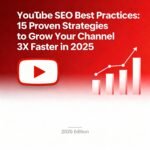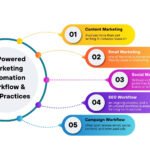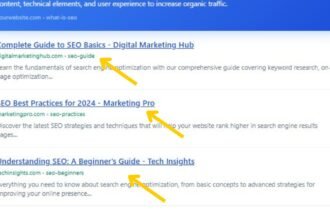Let’s face it: the way people search online has radically changed. Gone are the days when users typed stiff, robotic keywords into Google like “best marketing agency Lagos.” Today? They’re simply asking, “What’s the best agency near me?” Or even more directly, “What’s the best marketing agency in Lagos for tech startups?” Whether it’s through voice search on Alexa, casual chats with AI tools like ChatGPT, or question boxes in Google’s Search Generative Experience (SGE), the expectation is the same: get a clear, direct answer instantly.
That shift is exactly why more businesses and content creators are urgently asking: “What is Answer Engine Optimization (AEO)?”
Because traditional SEO focused on ranking web pages isn’t enough anymore. People aren’t always clicking through ten blue links. They’re talking to AI. They’re asking their phones. They’re looking for immediate answers, not endless options.
Here’s the key reality:
Over 50% of searches in 2025 are conversational, voice-based, or routed through AI-powered tools.
That stat alone should be your wake-up call. Answer Engine Optimization (AEO) is the natural evolution of SEO for this new search era. While SEO aims to get your page ranked, AEO positions your content to be the answer—whether it’s surfaced in a featured snippet, read aloud by a smart speaker, or cited directly in an AI’s response.
As someone deeply embedded in the intersection of AI-powered search, user intent analysis, and content strategy, I can tell you this: If you want your brand to remain visible, trusted, and competitive, understanding what Answer Engine Optimization (AEO) is—and applying it—is no longer optional. It’s essential.
What is Answer Engine Optimization (AEO)?
At its core, Answer Engine Optimization (AEO) is exactly what it sounds like: the process of optimizing your content so it becomes the answer AI-driven platforms choose to serve up — whether that’s Google, Bing Copilot, Siri, Alexa, or ChatGPT. Instead of focusing solely on climbing the ranks of traditional search engine results pages (SERPs), AEO ensures your content is structured, written, and technically prepared to deliver clear, concise, and authoritative answers.
If you’ve ever had your content appear in a featured snippet, been cited in a Knowledge Graph, or heard it read out loud by a voice assistant, congratulations — that’s AEO in action. It’s a step beyond SEO because Answer Engine Optimization (AEO) isn’t about winning clicks; it’s about owning the answer itself.
How AEO Works in Simple Terms:
Traditional SEO aims to get someone to click on your site. AEO aims to have AI or search platforms extract your content and display it directly. Think zero-click searches, voice search results, and AI-generated summaries. That’s why AEO prioritizes user intent, conversational clarity, and structured content formats — not just keywords.
| Aspect | Traditional SEO | Answer Engine Optimization (AEO) |
| Primary Goal | Rank pages in search results | Provide direct answers through AI/voice |
| Search Behavior | Short keywords | Conversational search, question-based |
| Measurement | Clicks, traffic | Featured snippets, AI mentions, voice search visibility |
| Content Structure | Long-form, keyword-heavy | Concise, structured answers |
Why This Matters:
With AI-driven platforms reshaping how we access information, Answer Engine Optimization (AEO) aligns your content with how people are asking questions today — through AI-powered search and conversational interfaces designed to serve immediate, direct answers.
When you understand and implement AEO, your content becomes more than visible. It becomes irreplaceable.
Why Answer Engine Optimization (AEO) Matters More Than Ever in 2025
The way people search today has fundamentally shifted. Thanks to the rise of AI-powered search engines, voice assistants, and chatbots, users now expect precise, instant, and accurate answers without having to scroll through a dozen blue links or read lengthy articles.
Think about how you use search today:
- You ask Siri for directions.
- You ask ChatGPT for a quick definition.
- You ask Google’s Search Generative Experience for recommendations — not links, but answers.
This is where Answer Engine Optimization (AEO) comes in. Instead of simply optimizing content for keywords and backlinks, AEO ensures your content is ready to be extracted as the answer itself. Whether through a featured snippet, voice search, AI chat interface, or Google’s Knowledge Graph, AEO helps you meet users at the precise moment they’re asking.
Why Now? Consider the Stats.
63% of users trust AI-powered search tools like ChatGPT or Gemini for recommendations over traditional search engines (Source: Spekit, 2025).
Over 50% of searches in 2025 are conversational or voice-based (Sources: Brand 2 Grand).
That means the majority of your potential customers are no longer typing clunky keywords—they’re asking conversational questions, expecting clear and direct answers. This shift is powered by NLP (Natural Language Processing) and sophisticated AI models like GPT-4 and BERT, which prioritize user intent and conversational clarity over simple keyword matching.
Why AEO Isn’t Optional Anymore
If your content isn’t structured for Answer Engine Optimization (AEO), you’re simply invisible to these platforms. You’re leaving brand visibility, trust, and authority positioning on the table.
AEO gives you access to the top of AI results, voice assistants, and knowledge panels—the new battleground for attention in the digital world.
In short: SEO helps you rank.
AEO helps you answer.
And in 2025, being the answer is what wins.
How Does Answer Engine Optimization (AEO) Work?
If you’re serious about mastering Answer Engine Optimization (AEO), you need to understand this: AEO isn’t magic—it’s methodical. It’s about aligning your content with how AI-powered search platforms think, structure information, and deliver responses. Here’s exactly how it works.
1. Start with User Intent Research
Forget keyword stuffing. AEO starts with understanding questions, not keywords.
People now search with conversational, question-based phrases like:
- “What is Answer Engine Optimization (AEO)?”
- “How does AEO improve visibility in AI search?”
- “What’s the difference between SEO and AEO?”
You need to research not just what people search for, but how and why they’re asking those questions. Tools like Answer The Public, Google’s People Also Ask, and Ahrefs help uncover these user intents.
Why it matters: Answer engines prioritize clarity of user intent over traditional keyword density.
2. Optimize for Direct Answers
Your content must be formatted to lead with the answer. Think:
- Short, direct definitions.
- Bullet points summarizing key facts.
- Clear headers breaking down solutions.
For example, the answer to “What is Answer Engine Optimization (AEO)?” should appear immediately after the question—not buried under 600 words of fluff.
Why it matters: AI engines prefer structured clarity over verbose explanations.
3. Apply Structured Data (Schema.org)
Technical optimization plays a huge role. Schema markup (FAQ, How-To, Article) tells AI and search engines:
“This content is formatted for answers.”
Schema helps your pages appear in:
- Featured snippets
- Google’s Knowledge Graph
- Voice assistant search results
Why it matters: Structured data signals authority and improves extraction accuracy.
4. Write for AI and Voice
The rise of voice search optimization means your writing style needs to mirror how people speak, not just how they type. That means:
- Conversational language.
- Natural phrasing.
- Clear, concise sentences.
Break content into digestible chunks: bullet lists, numbered steps, tables—formats AI loves for direct answers.
Why it matters: Conversational search and AI prioritizes content that’s easy to parse and easy to quote.
Summary of How AEO Works:
| Step | Focus | Outcome |
| User Intent | Questions, not keywords | Aligns with conversational search |
| Direct Answers | Lead with clarity | Increases AI extraction chances |
| Structured Data | Schema markup | Boosts AI/voice visibility |
| Writing Style | Conversational, clear formatting | Optimizes for AI and voice assistants |
By following these steps, your content won’t just rank—it’ll answer. That’s the heart of Answer Engine Optimization (AEO).
Key Differences Between Traditional SEO vs. Answer Engine Optimization (AEO)
If you’ve been wondering whether Answer Engine Optimization (AEO) is just a rebranded version of SEO, let’s clear that up right now. While both share the goal of improving online visibility, the methods, priorities, and outcomes between the two are fundamentally different.
Traditional SEO focuses on ranking your website pages to generate clicks. AEO, on the other hand, is focused on making sure your content is directly extractable as an answer—whether by Google’s featured snippets, voice search assistants, or AI-powered platforms like ChatGPT.
Here’s a simple breakdown of where they differ:
Traditional SEO vs. Answer Engine Optimization (AEO)
| Criteria | Traditional SEO | Answer Engine Optimization (AEO) |
| Primary Focus | Page rankings, website traffic | Direct answers in AI and search engines |
| Search Behavior | Short, keyword-based queries | Conversational, question-based search |
| Metrics | Click-through rate, backlinks, traffic | Featured snippets, AI mentions, voice search visibility |
| Content Structure | Long-form, detailed articles | Concise, structured answers for extraction |
| End Goal | Drive clicks to site | Provide the answer within the search itself |
Why This Matters in 2025 (and Beyond)
Thanks to AI advancements, users aren’t always looking to click through and read 2,000 words. Often, they want the direct answer immediately.
This is where Answer Engine Optimization (AEO) shines—it’s not about bringing someone to your site, it’s about ensuring your brand delivers the answer upfront, wherever the question is asked.
In an era dominated by AI-powered search, voice assistants, and chatbots, optimizing for AEO helps you own the conversation—literally.
If you don’t adapt? Your competitors will.
If you do? Your content gets positioned as the authority trusted by AI, search engines, and your audience.
Quick Example:
Question: What is Answer Engine Optimization (AEO)?
- SEO Approach: Write a 2,500-word blog post, hoping to rank on page 1.
- AEO Approach: Start the post with a direct, 2-3 sentence answer, structured for easy AI extraction, supported by clear schema markup.
5 Practical Strategies to Implement Answer Engine Optimization (AEO)
So now you understand what Answer Engine Optimization (AEO) is and how it differs from traditional SEO. But theory alone won’t help your content surface as the answer. You need actionable strategies. Below are the 5 proven methods I use to ensure my content is optimized for AI-powered search, conversational queries, and direct answers.
1. Leverage Question-Based Keyword Research
To win at Answer Engine Optimization (AEO), you have to think like your audience. People no longer type “best marketing tool.” They ask:
- “What is the best marketing tool for small businesses in 2025?”
- “How does AI help with content marketing?”
Use tools like:
- Google’s People Also Ask
- Answer The Public
- Ahrefs Questions Explorer
- Semrush Keyword Magic Tool
These tools help you uncover question-based, conversational search queries—the lifeblood of AEO.
Tip: Focus on queries starting with What is, How does, Why do, Best way to—these are highly favored by AI and voice assistants for direct answers.
2. Lead with Direct Answers First
Answer engines don’t want the buildup. They want the answer—immediately.
When someone asks, “What is Answer Engine Optimization (AEO)?”, don’t make them wade through an anecdote about Google’s history.
Instead:
Start your content with a clear, concise definition or answer in the first 2-3 sentences.
Follow it up with expanded context, examples, and deeper insights.
Tip: Use bullet points, numbered lists, and tables to deliver information in easily extractable formats.
3. Utilize Schema Markup for FAQs, How-Tos, Knowledge Panels
If you’re not using structured data (Schema.org markup), you’re leaving AEO opportunities on the table. Schema helps search engines understand:
- This is a question-answer format.
- This is a how-to guide.
- This is product information.
Structured data is essential for appearing in:
- Featured Snippets
- Knowledge Graphs
- AI-powered search responses
Tip: Prioritize FAQ Schema and How-To Schema for most informational content.
4. Optimize for Voice Search & Conversational Queries
Voice search is conversational. That means your content must mirror natural speech patterns. Think short sentences. Simple words. Direct tone.
Optimize for queries like:
- “What’s the best tool for…”
- “How do I…”
- “What is…”
Integrating long-tail conversational keywords increases your chances of being picked up by voice assistants and AI tools.
Tip: Run your content through tools like Grammarly or Hemingway Editor to ensure readability mimics spoken language.
5. Write Authoritative, Clear, Organized Content
Authority isn’t just about expertise—it’s about clarity. AI chooses content that’s easy to understand, well-organized, and clearly answers the user’s intent.
Best practices:
- Break content into clear sections with H2/H3 headers.
- Anticipate follow-up questions and answer them within the same content.
- Write in an authoritative, but accessible tone.
Tip: Think of your content as training material for AI. The clearer you are, the more likely AI engines will trust and surface your answers.
Quick Recap of AEO Implementation Strategies:
| Strategy | Purpose |
| Question-based keyword research | Aligns with conversational search |
| Lead with direct answers | Increases AI answer extraction |
| Implement structured data | Improves AI visibility (Snippets, Schema) |
| Optimize for voice & conversation | Matches AI and voice search queries |
| Write clear, authoritative content | Builds trust with AI and users |
5 Common Mistakes to Avoid with Answer Engine Optimization (AEO)
If you want to succeed with Answer Engine Optimization (AEO), knowing what not to do is just as important as knowing what works. AEO isn’t SEO with a fresh coat of paint—it’s a strategic shift toward clear, direct, AI-ready answers. Here are the most common mistakes I see businesses and content creators make when trying to optimize for AI-powered search and conversational search.
1. Writing for Algorithms, Not Humans
AEO is all about user intent. If your content is stuffed with awkward keywords and robotic phrasing, AI won’t pick it. Neither will people.
Modern AI, powered by natural language processing (NLP), favors conversational, clear, and human-sounding content.
Do this instead: Write naturally, as if you’re answering a question in conversation—because AI tools mimic human questions.
2. Burying the Answer in Long-Winded Content
You don’t need to “warm up” your answer with a long introduction. AI and voice assistants extract immediate, direct answers. If your key points are buried halfway down the page, you’re reducing your chances of being surfaced.
Do this instead: Lead with the answer—fast. Follow with supporting context.
3. Ignoring Structured Data (Schema.org)
Without structured data, your content might never reach Google’s Knowledge Graph, featured snippets, or AI outputs. Schema is what signals to search engines: “This content is built to answer questions.”
Do this instead: Implement FAQ Schema, How-To Schema, and Article Schema consistently.
4. Focusing Solely on Desktop Search Behavior
Most conversational searches happen on mobile devices or through voice assistants. If you’re only optimizing for desktop, you’re missing a huge slice of the market.
Do this instead: Optimize for mobile-first, voice-first interactions. Keep answers short, snappy, and clear.
5. Treating AEO as a One-Off Task
Answer Engine Optimization (AEO) isn’t something you do once and forget. AI evolves. User behavior changes. Conversational queries shift.
Ongoing optimization is non-negotiable.
Do this instead: Regularly audit your content for opportunities to improve clarity, structure, and answer-readiness.
Summary of AEO Mistakes to Avoid:
| Mistake | Impact | Solution |
| Writing for bots, not humans | Reduces clarity and engagement | Write conversationally and clearly |
| Burying answers | Missed AI extraction opportunities | Lead with direct answers |
| Skipping structured data | Limits visibility in AI/voice search | Implement Schema markup |
| Ignoring voice/mobile optimization | Overlooks how users actually search | Optimize for conversational search |
| One-time AEO effort | Leaves content outdated, less competitive | Treat AEO as ongoing, evolving strategy |
Conclusion: Why “What is Answer Engine Optimization (AEO)?” is the Question Every Marketer Should Be Asking Now
If you’ve read this far, you already understand why the question “What is Answer Engine Optimization (AEO)?” is more than just industry jargon—it’s a strategic imperative for any brand, creator, or business that wants to stay visible in the age of AI-powered search and conversational search behaviors.
Here’s the bottom line: The search landscape has changed forever.
Users no longer want a list of options—they want direct answers from trusted sources. Whether it’s a voice assistant, a chatbot like ChatGPT, or Google’s Search Generative Experience (SGE), people are asking questions expecting instant, clear, and accurate answers. And if your content isn’t optimized to deliver those answers, you’re simply invisible to this growing share of traffic.
Why AEO is the Future of Visibility:
- AI-powered search platforms prioritize clear, structured, authoritative content.
- Voice search optimization is critical as more users engage via mobile and assistants.
- Structured data (Schema) bridges your content to AI engines for extraction.
- User intent-focused strategies make your brand more useful, more trusted, and more cited.
Answer Engine Optimization (AEO) is not replacing SEO—it’s the evolution of SEO. While SEO still gets you ranked, AEO gets you remembered. It positions you as the authority answer, not just another clickable link buried in results.
If you want to future-proof your content strategy, Answer Engine Optimization (AEO) is where you start.
Stop asking “How can I rank better?”
Start asking: “How can I be the answer?”
That’s the mindset shift Answer Engine Optimization (AEO) demands—and rewards.
Frequently Asked Questions on What is Answer Engine Optimization (AEO)?
These FAQs help reinforce the blog’s authority, boost SEO through conversational search queries, and give you more opportunities to rank for “What is Answer Engine Optimization (AEO)?” and related terms.
What is Answer Engine Optimization (AEO) in simple terms?
Answer Engine Optimization (AEO) is the process of optimizing your content so AI tools, voice assistants, and search engines can easily extract and deliver it as a direct, clear answer to user questions. It’s about providing answers, not just chasing rankings.
How is AEO different from traditional SEO?
Traditional SEO focuses on improving rankings to drive website clicks. AEO focuses on ensuring your content is structured and optimized to be extracted directly by AI-powered search engines, voice assistants, and chatbots. AEO is about answers, not just traffic.
Why is Answer Engine Optimization (AEO) important in 2025?
Over 50% of searches in 2025 are conversational or voice-based. Users expect immediate answers from AI tools like ChatGPT or Google’s Search Generative Experience (SGE). If your content isn’t AEO-optimized, you risk losing visibility to competitors who are.
How do I optimize my content for AEO?
Start by understanding user intent and crafting content that leads with clear, concise answers. Use structured data (Schema.org), optimize for voice search, and write in a conversational tone. Break content into bullet points, tables, and FAQs for easy AI extraction.
What types of businesses should focus on AEO?
Any business that relies on online visibility, brand authority, and organic search traffic should prioritize AEO. This includes SaaS companies, ecommerce brands, B2B service providers, content creators, and local businesses looking to capture AI and voice search traffic.
Does Answer Engine Optimization (AEO) replace SEO?
No. AEO complements SEO. Traditional SEO helps you rank. AEO helps you get cited as the answer. Together, they ensure your brand stays visible across evolving search landscapes—from search engines to AI platforms.
Is AEO only relevant for Google?
No. AEO applies to all AI-driven search platforms, including Google, Bing Copilot, ChatGPT, Siri, Alexa, and Gemini. Any platform that delivers answers instead of links benefits from AEO strategies.













